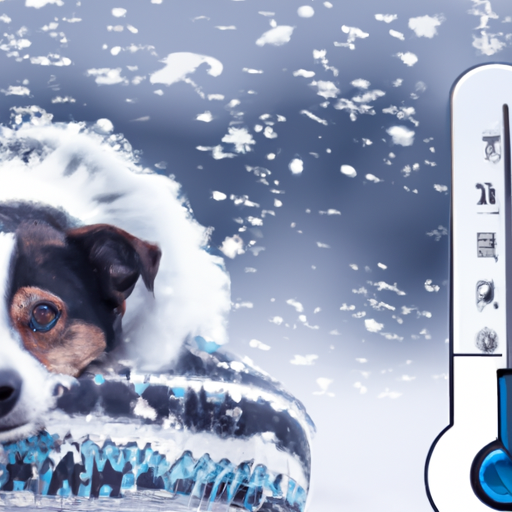Ever wondered how your furry friend fares in the biting cold? Unlike humans, dogs have a complex temperature regulation system that can handle different weather conditions.
However, there’s a limit to what they can endure. Just like us, our canine companions can experience discomfort and potential health risks when exposed to freezing temperatures. The level of coldness a dog can tolerate depends on various factors including their breed, size, and overall health condition. Ignoring these factors could lead to chilling scenarios such as hypothermia.
So it’s critical to know when the temperature is too low for your pup. This article will provide you with an understanding of canine temperature tolerance and guide you through keeping your four-legged friends safe during colder months. Remember, safeguarding your pet from extreme cold isn’t just about comfort—it’s about ensuring their health and well-being too.
Understanding Canine Temperature Regulation
You’ve got to understand, your furry friend doesn’t regulate temperature in the same way you do, and that’s what makes cold weather a bit tricky for them. Dogs utilize thermoregulation mechanisms different from ours.
Part of their ability to combat chill relies heavily on canine fur insulation. This coat acts as a barrier against the cold, trapping body warmth close to the skin.
However, not all dogs have thick coats or underfur for optimal insulation. Plus, factors like age, health condition, and breed can affect how well they fend off winter’s nip. So while some breeds thrive in frosty conditions due to their double-layered fur, others may shiver at slightly lower temperatures.
Remember, it’s our responsibility to ensure our pets are comfortable and safe in varying weather conditions!
Evaluating Your Pet’s Tolerance to Cold
Isn’t it fascinating how your furry friend’s ability to withstand chilly weather can vary greatly depending on its breed, size, and overall health?
Some breeds like Huskies or Malamutes are built for the cold. Yet smaller, thinner-coated dogs might shiver at the slightest breeze.
To help evaluate your pet’s tolerance to cold, consider outfitting them in seasonal dog apparel. Sweaters and coats can provide an extra layer of warmth for those chilling walks or play sessions outside.
Additionally, outdoor shelter options should be considered if you have a backyard pooch. Insulated dog houses offer protection from harsh elements and can keep your pet comfortable.
Remember though – no matter their breed or size – all pets deserve comfort and safety during winter months.
The Impact of Breed and Size on Cold Sensitivity
Just like a thick-coated Husky might prance joyfully through a snowstorm, your petite Chihuahua could be shivering under a blanket at the first sign of frost. This is due to breed-specific insulation and size-related heat retention.
-
Breed-Specific Insulation: Some breeds have a double coat or longer fur, providing more insulation against the cold. For instance, St. Bernards and Siberian Huskies are designed for colder climates.
-
Size-Related Heat Retention: Larger dogs tend to retain heat better than smaller ones because they have a smaller surface area compared to their volume.
-
Weight: Body fat acts as an internal heater, so leaner dogs may feel colder quicker.
-
Age and Health: Older or sickly dogs struggle with temperature regulation, making them more susceptible to the cold.
Remember, each dog’s tolerance differs – always monitor closely!
Signs of Hypothermia in Dogs
While we’ve established that our furry friends can indeed feel the chill, let’s now dive into understanding the signs of hypothermia in them. Hypothermia in dogs occurs when their body temperature falls below normal, which is typically around 101°F to 102.5°F.
Here are some signs to look out for:
| Signs | Explanation |
|---|---|
| Shivering | An early sign; your dog’s body is trying to generate warmth |
| Lethargy | Lack of energy may indicate a drop in body temperature |
| Weakness | Difficulty walking or standing could be a warning sign |
| Breathing problems | Slow, shallow breathing might signal hypothermia |
| Unconsciousness | A severe stage of hypothermia |
If you notice these symptoms, immediate Hypothermia Treatment is crucial. Prevention Strategies include avoiding prolonged exposure to cold and providing adequate warmth and shelter. Remember, it’s always better safe than sorry!
Keeping Your Dog Safe in Winter Months
In fact, a whopping 75% of pet owners admit they’re not fully prepared for winter emergencies. That’s why it’s crucial to strategize how to keep your furry friend safe during those chilly months. Here are some tips:
-
Winter gear for dogs: Invest in dog-friendly jackets and boots that can protect them from harsh weather conditions.
-
Indoor exercise alternatives: Play fetch indoors, use staircases for a fun run or setup obstacle courses to keep your dog physically active.
-
Limit outdoor time: Minimize the time spent outside when temperatures drop drastically. Quick bathroom breaks should suffice.
-
Check their paws: Ice and salt can cause damage. Clean and dry their paws after each outing.
Remember, preparation is key in ensuring your beloved pet stays healthy and happy throughout the winter season.
Frequently Asked Questions
What types of dog clothing or accessories can help my pet stay warm in cold weather?
Consider dog sweaters, boots, and thermal blankets. A nutritious winter dog diet can boost your pet’s body heat. Regular cold-weather grooming will combat dry skin and increase fur warmth. Always prioritize their comfort and safety.
How can I tell if my dog is enjoying the snow or is actually distressed by the cold?
Observe your dog’s behavior during snow play for safety. If they’re energetic and playful, they’re likely enjoying it. However, canine cold symptoms like shivering, lethargy, or whining suggest distress due to the cold.
Are there specific dog breeds that are naturally resistant to cold temperatures?
Yes, certain breeds are naturally more cold resistant. Huskies, Malamutes, and Saint Bernards have thick coats adapted for chilly climates. However, breed acclimatization plays a part too, so always monitor your dog’s comfort level.
In which indoor areas should I keep my dog during the cold months to ensure they stay warm?
During the chilly months, ensure your dog’s warmth by keeping them in well-insulated areas of your home. Prioritize their nutrition; a balanced diet aids in maintaining body heat. Warm bedding also enhances pet insulation.
Is it safe to use human heating pads or blankets for dogs during cold weather?
While human heating pads may seem like a quick fix, it’s safer to use Pet safe Warmers designed for dogs. They’re better suited for Canine Hypothermia Prevention and won’t risk overheating or burns.
Conclusion
In the ice-cold grip of winter, remember: your pup’s not an Arctic explorer! Their tolerance to cold can vary dramatically. Smaller breeds and short-haired dogs may shiver at anything below 45 degrees. Hypothermia is a serious risk, so keep an eagle eye out for signs like constant shivering and lethargy.
So bundle them up, limit outdoor time when it’s chilly, and give them a warm snuggle. They’ll love you to the moon and back for it!



